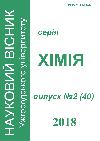ВИВЧЕННЯ КОМПЛЕКСОУТВОРЕННЯ У СИСТЕМІ Fe(II) – ГІДРОКСИЛАМІН
DOI:
https://doi.org/10.24144/2414-0260.2018.2.24-30Ключові слова:
гідроксиламін, ферум(II), високоспиновий комплекс, низькоспіновий комплексАнотація
We have received the complexes of iron (II) with hydroxylamine for first time. The experiments were carried out in anaerobic conditions in the atmosphere of nitrogen. Absolute alcohol (methanol) was used as solvent. Two complexes were received in the solution: a dark green one (pH 3-4) and brownish red one (pH 6.2-8.0). Complexes are unstable. The existence of a green complex of iron (II) with hydroxylamine at pH 3-4, due to the presence in the solution of the protonated form of hydroxylamine (NH3OH+, pKa = 6,06). The existence of a brownish red complex of iron (II) with hydroxylamine at pH 6.2-8.0 is evidently due to the existence of the molecular form of hydroxylamine (NH2OH), since at high pH values there is a hydroxylamine anion (NH2O-, pKa = 9,4) in the solution. The absorption spectrum of complexes have been taken. The spectrum character shows that the green composition is high spin and the red one is low spin complexes of Fe (II). The parameter 10Dq was found for the green complex: 10Dq = 9756 sm-1. The complexes have the octahedral slight tetragonal destroyed structure.
With an increase in the concentration of hydroxylamine in the solution in the range of pH 4-6, a mixture of complexes is present in the system. Therefore, the exact composition of the green and brownish red complexes cannot be established. It is possible that the green complex of iron (II) is mixed ligand – chloride-hydroxylamine, and red – hexahydroxylamine [Fe(NH2OH)6]Cl2.
The instability constant of brownish red complex have been counted with the help of Babko’s method: Kins = (2,86±0,36)´10-3.Посилання
Kharitonov Yu.Ya., Sarukhanov M.A. Khimiya kompleksov metallov s gidroksilaminom. M.: Nauka, 1977. S. 294 (in Russ.).
Kharitonov Yu.Ya., Sarukhanov M.A. Koordinatsionnaya khimiya soyedineny metallov s gidroksilaminom i prosteyshimi ego proizvodnymi vvedeniye. Koordinatsionnaya khimiya. 1978, 4(3), 323–328 (in Russ).
Wieghardt K. Mechanistic studies involving hydroxylamine. Adv. Inorg. Bioinorg. Mech. 1984, 3, 213–274.
Ivashkovich Ye.M., Skobley M.I. Izucheniye kompleksnykh soyedineny margantsa(ІІ), kobalta(ІІ) i nikelya(ІІ) s gidroksilaminom. Zhurn. neorgan. khimii. 1974, 19(3), 760–765 (in Ruus.).
Ivashkovich Ye.M., Zhelekhovskaya L.M. Kompleksnye soyedineniya khroma(ІІІ) s gidroksilaminom. Zhurn. neorgan. khimii. 1979, 24(1), 61–67 (in Russ.).
Ivashkovich Ye.M. Izucheniye gidroksilaminovykh kompleksov margantsa(ІІ). Zhurn. neorgan. khimii. 1982, 27(3), 704–710 (in Russ.).
Ivashkovich Ye.M., Tovt G.D. Izucheniye sostoyaniya ionov medi v rastvore v prisutstvii gidrokislamina. Zhurn. neorgan. khimii. 1978, 23(2), 425–429 (in Russ.).
Ivashkovy`ch O.M., Vasy`ly`k L.R. Doslidzhennya kompleksu oksovanadiya(IV) z gidroksy`laminom. Naukovy`j visny`k Uzhgorods`kogo universy`tetu. Seriya «Khimiya». 1999, 4, 53–56 Iin Ukr.).
Rudolf M., Einsle O., Neese F., Kroneck P.M.H. Pentahaem cytochrome c nitrite reductase: reaction with hydroxylamine, a potential reaction intermediate and substrate. Biochem. Soc. Trans. 2002, 30(4), 649–653.
Asirvatham S., Khan M.A., Nicholas K.M. A Decairon Cluster Devoid of Polydentate Ligands. Inorg. Chem. 2000, 39(9), 2006–2007.
Singros R., Goldshmidt H. Z. Anorg. Chem. 1897, 5, 130.
Akhmetov N.S. Neorganicheskaya khimiya. M.: Vysshaya shkola, 1969. S. 599 (in Russ.).
Nikolsky B.P. Spravochnik khimika. M.: Khimiya, 1965. T. 3. S. 128 (in Russ.).
Klyuchnikov N.G. Rukovodstvo po neorganicheskomu sintezu. M.: Khimiya, 1965. S. 184, 227 (in Russ.).
Gordon A., Ford R. Sputnik khimika. M.: Mir, 1976. S. 245 (in Russ.).
Koryakin Yu.V., Angelov I.I. Chistye khimicheskiye veshchestva. M.: Khimiya, 1974. S. 107 (in Russ.).
Shvartsenbakh G., Flashka G. Kompleksometricheskoye titrovaniye. M.: Khimiya, 1970. S. 239 (in Russ.).
Ballhausen C.J. Introduction to ligand field theory. McGraw-hill book company, inc. New York, San Francisco, Toronto, London. 1962. P. 252.
Ivashkovich Ye.M., Grigo V.V. Protsess protonirovaniya gidroksilamina. Ukr. khim. zhurn. 1986, 52(6), 578–582 (in Russ.).
Lumme P., Lahermo P., Tummavuori J. Thermodynamics of the Ionization of Hydroxylamine and Nitrous Acid in Water. Acta Chem. Scand. 1965, 19, 2175–2188.
Bulatov M.I., Kalinkin I.P. Prakticheskoye rukovodstvo po fotometricheskim metodam analiza. L.: Khimiya, 1986. S. 432 (in Russ.).
##submission.downloads##
Номер
Розділ
Ліцензія
Ліцензування
Стаття та будь-який пов’язаний з нею опублікований матеріал поширюється за ліцензією Attribution-NonCommercial 4.0 International (CC BY-NC 4.0)
Умови цієї ліцензії не впливають на права автора чи іншого творчого виконавця захищати цілісність і право власності на свою роботу.
Авторське право на макет журналу та обкладинки повністю належить ДВНЗ "Ужгородський національний університет".
Весь контент публікується добросовісно, і думки, висловлені авторами, є тільки їхніми та не обов’язково відображають точку зору ДВНЗ "Ужгородський національний університет".
Автори надають редакційно-видавничому відділу ДВНЗ "Ужгородський національний університет" ліцензію на публікацію статті та ідентифікують себе як першовидавця.
Авторське право
Авторські права на будь-яку статтю зберігаються за автором(ами).
Публікацію статті мають схвалити всі автори та відповідальні органи інститутів, в яких виконувалося дослідження, якщо такі є.
Автори можуть уповноважити одного зі своїх співавторів діяти від їхнього імені та бути автором-кореспондентом, який відповідає за листування з редакційною командою журналу.
Автори можуть надати будь-якій третій стороні право вільно використовувати статтю за умови зазначення авторів та належного оформлення цитування.

